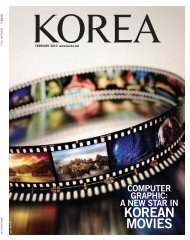KOREAN CINEMA 2 0 0 7
KOREAN CINEMA 2 0 0 7 - Korea.net
KOREAN CINEMA 2 0 0 7 - Korea.net
- No tags were found...
You also want an ePaper? Increase the reach of your titles
YUMPU automatically turns print PDFs into web optimized ePapers that Google loves.
Korean Film Council<br />
Korean Film Council (KOFIC) is a government-supported, self-administered<br />
body with its primary goal in stimulating the growth and development of Korean<br />
films through funding, research, policy development, education and professional<br />
training. It also works to further develop global markets for Korean films and to<br />
promote intercultural understanding through film-based exchanges.<br />
KOFIC’s Nature & Vision<br />
Although KOFIC receives its budget from the government, and is committed with the role<br />
of supporting cinema by the Ministry of Culture and Tourism, it still maintains a certain<br />
measure of independence and specialization in communicating with and representing the<br />
needs of Korea’s filmmaking community.<br />
While the Korean film sector spends about US$ 350 million yearly in production funding,<br />
KOFIC’s budget for 2007 comes to about US$ 34 million, but KOFIC’s role extends beyond<br />
simply providing money for the industry, as it actively assists in developing Korean cinema<br />
in more diverse nature that provides an open forum for all filmmakers regardless of their<br />
background, in addition to offering an understanding of different cultures for people to look<br />
at the world in broader terms.<br />
The means of carrying out such roles include supports in funding, development, production,<br />
and distribution of Korean films concerning contemporary Korean society and the people;<br />
rationalization of the industry through research and policy-development and with programs<br />
including nationwide computerized box office data system; technical developments<br />
such as digital cinema, which can facilitate and broaden the accessibility of producing<br />
and exhibiting more diverse films; extending the education on ‘cinema as an art form’ to<br />
broader population through media centers, cinemathéques, publications and film-related<br />
organizations; and educating and re-training human resources for the industry through<br />
Korean Academy of Film Arts (KAFA) and KOFIC’s other professional programs.<br />
Internationally, KOFIC strives for diverse cultural exchange through cinema, while promoting<br />
Korean films in overseas markets by working with film festivals and other organizations,<br />
and through research. KOFIC also produces publications that include guidebooks and<br />
catalogues as well as those on the state of the Korean film industry.<br />
In addition, KOFIC is the leading figure in the establishment of Asian Film Network<br />
(AFIN) for the purpose of promoting cultural exchanges among the countries involved<br />
and advancing their respective film industries at the same time. Advantages of an Asian<br />
Cinema bloc in terms of cooperation and exchange is that there is a cultural familiarity<br />
and economic prosperity to be shared in the region, and with Korea happens to be at a<br />
certain peak in its development, programs such as Asian Film Academy (AFA) and KAFA<br />
Asian Scholarship Program offer selected participants from other Asian nations have the<br />
opportunity to experience firsthand the results from experiences of trial and error and help<br />
advance the development of other Asian film industries as well as Asian cinema bloc itself.<br />
To give an idea of the past decade’s developments in Korea, last year, cinema admissions<br />
for both Korean and foreign films saw a record-breaking 153.4 million tickets sold, while per<br />
capita film attendance went up to 3.1. This is in contrast to the 40.8 million tickets sold in<br />
1995 when the population only saw a single film per capita yearly.<br />
In the same decade or so since contemporary Korean cinema has seen its so-called<br />
renaissance, the number of films produced went from 64 in 1995 to 110 in 2006. Market<br />
share for Korean films went from 20.9% to 63.8% in 2006, the highest ever since upward<br />
trend began to show in 1996. Even with the enforcement of reduced Screen Quota that<br />
went effective in July 1, 2006, the rise in Korean cinema is astonishing. With expanding<br />
market size as shown by growing number of nationwide screens to 1,847, an increase of<br />
12.1% from 2005, KOFIC is concerning itself with keeping the diversity of Korean market<br />
for artistic and independent-oriented cinema as well.<br />
However, the eventual goal of KOFIC is to elevate the Korean film industry to top-five rank<br />
of the world by providing continuous assistance to the industry and its people. In order<br />
to achieve such goal, it has set a five-year goal in five primary categories. By the end of<br />
2011, KOFIC strives to 1) increase the size of domestic market, from 140 billion Korean<br />
Won to 300 billion Korean won; 2) increase the world film market share from 1.6% to<br />
3%; 3) increase the audience size for Korean cinema from 150 million to 300 million; 4)<br />
maintain the audience share along the 50% level; and 5) increase the revenue from export<br />
of Korean films, from 76 billion Korean Won to 300 billion Korean Won. KOFIC hopes to<br />
achieve this goal by strengthening of Korean films’ global competitiveness, building of<br />
production and exhibition infrastructure for art and independent films, as well as market<br />
diversification through bilateral international exchanges. Main issues that it faces and<br />
must solve are maintaining of diversity; securing of solid and stable production investment<br />
environment; welfare system for film professionals, incubation of skilled professional staff<br />
and enhancement of technical standards; expansion into overseas promotion; advancement<br />
of balancing among regional audio-visual industry; and film policy reforms.<br />
By achieving these goals through KOFIC’s 5 year programs, the future will be bright for<br />
Korean films as its industry will position itself as the leading core contents industry in<br />
today’s knowledge-based society, where it will settle in as a main service industry in Korea<br />
by materializing its high-revenue generating value while creating diverse environment for<br />
diversity-oriented and commercial, low-budget and blockbuster films to exist and maintain<br />
the balance between the two. The film industry will also maintain its high competitive<br />
nature within a domestic market while becoming the major power in global film community.<br />
New Strategy for Korean Films<br />
Although Korean films have shown remarkable successes during the last decade, it is<br />
facing several newchallenges that may threaten its continuous advancement. This is mainly<br />
due to structural problems within Korea’s film industry, with three issues that stand out.<br />
First, generalization of large-scale production scale and wide-release distribution have<br />
resulted in monopolizing of screen venues by a handful of blockbuster films, which in return<br />
made it difficult for producing and exhibiting low-budget independent art films and other<br />
diverse-natured films. Such trend is dangerously close to the failure of Hong Kong cinema<br />
with the limited subject matter (in Hong Kong’s case, martial-arts action films,) and reliance<br />
on star-power that gave a short-term popularity eventually losing its power.<br />
Another major issue the industry faces is inferior labor conditions and treatments towards<br />
field production staff, resulting in exodus of outstanding film professionals from the<br />
industry and on-location conflicts during the field production, which work as detrimental<br />
elements in long-term advancement of Korean films. What’s more, reduction in Screen<br />
8 9
















